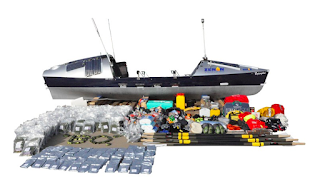One of the women is an undergraduate in my department, Eliza Dawson, an excellent student who plans of going to graduate school next year to study the earth's climate system. Eliza is also a member of the UW's fabled women's crew team, and thus is an accomplished athlete as well. Such an effort is not inexpensive and thus she is raising funds to support this effort (here and here).
I am intrigued by this ambitious project on many levels.
Eliza and compatriots will view and document the current state of the northeast Pacific at close hand. As many of you know the world's oceans have become a giant junk yard, particularly for floating plastic, and they will go through one of the worst garbage collection areas--the center of the east Pacific gyre (see images). They plan on taking pictures and documenting the debris they pass through.
They are also concerned about the impacts of climate change on the oceans and the planet, and Eliza plans on documenting the ocean surface temperatures and other characteristics as they row from the mainland to Hawaii.
I am also fascinated by the anthropological implications of the passage of humans from the mainland to the islands without the benefit of motorized transport. Could ancient Hawaiians have visited North America and vice versa? Eliza and friends will have a harder trip than native Americans, since they are not using sails, which would be quite useful for the route they are taking.
 |
| Boat and Supplies |
In order to participate in this effort, Eliza will have to raise about $20k during the next few months. So far she has raised several thousand dollars and is turning to crowdfunding to secure the remainder. If you would like to assist her, please go to her fundraising web site. I will certainly do so.
Finally, take a look at a video they produced about their upcoming trip.
Dealing with anthropogenic climate change and learning to live with our planet in a more sustainable way are two of the great challenges of our species. It is very encouraging to see a future young scientist willing to make such a tremendous exertion to bring attention to these important issues.






Thanks for championing their cause, Cliff. I have some good suggestions for Mahi and Tuna jigs for them to bring along to insure fresh, energy providing, delicious meals. I hope they're planning on bathing in the ocean occasionally, it's the best!
ReplyDeleteGood luck,
Dale
Great idea, and I wish them all the luck in the world. I do hope that they have some kind of emergency back up, in case things go south.
ReplyDeleteEd Gillett kayaked from Monterey to Maui solo in 1987. 63 days. It can be done!
ReplyDeleteWe will be following them from the comfort of home. Row row row! South Point - Big Island is the plastic capital of the Pacific.
ReplyDeleteWe ought to have a fleet of ships (solar powered or sailing) whose only job is the scoop up plastic trash. Is anyone- or any country- doing this?
ReplyDeleteThey ought to take 3-4 hour stints. Sleeping is better that way. That's what we did when I sailed across the Atlantic. And I hope it has sliding seats.
Gig Harbor Boats makes the sliding seat rigs for these boats. They sponsored 4 guys who tried to beat the record for the West to East Atlantic row.
ReplyDeleteHi Cliff, The team that rowed across the Atlantic to race might have some tips for the women. http://oarnorthwest.com/ And Roz Savage, who also rowed this Pacific route might have some other information. https://en.wikipedia.org/wiki/Roz_Savage (has links to her organization.)
ReplyDeleteGood luck to the women. It's a tough row.
Cliff, your image of floating plastic is a little deceptive. The vast majority of floating plastic in the oceans is microplastics that are invisible to the naked eye so they are unlikely to document a great deal of visible, floating plastic.
ReplyDeleteAlso, Ansel's plan of "scooping up" the trash wouldn't work because it would also necessitate removing all the fish and plankton from the area, as well.
Worth a read. This recent work opens up the "size of plastic" topic:
Deletehttp://www.latimes.com/science/sciencenow/la-sci-sn-garbage-patch-plastic-20180322-story.html?outputType=amp
I've sailed 5 times across that stretch of ocean, and I've got to say, rowing across it sounds fantastically difficult. I wish them good luck and a happy voyage!
ReplyDeleteOn one of the trips we trailed a little net on the surface to sample for plastic bits for the Ocean Cleanup project. As the previous poster mentioned, lots of little critters turn up in the nets too: jellyfish, crustaceans, etc...
Incredible! The garbage dump of our ocean is beyond comprehensible. It's time we take responsibility for this atrocity. Plastics should have huge taxes in place that directly go towards cleaning up our mess!
ReplyDelete